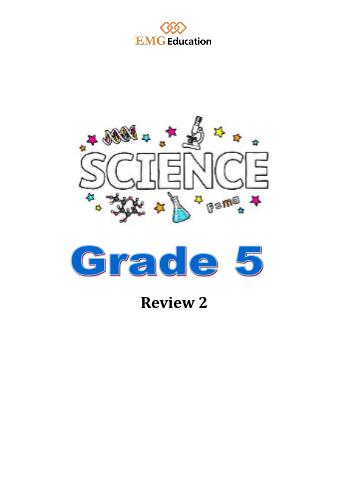Bài tập Tiếng Anh tích hợp Lớp 5 - Grade 5: Science Review 2
15. Daisy is investigating water resistance.
She makes five shapes out of clay and drops them in a thick liquid.
Daisy measures how long it takes for each shape to reach the bottom of the container.
15a. What variable does Daisy change in her experiment?
___________________________________
15b. Name one variable Daisy controls (keeps the same).
___________________________________
15c. Which shape will reach the bottom of the liquid quickest? Circle one
She makes five shapes out of clay and drops them in a thick liquid.
Daisy measures how long it takes for each shape to reach the bottom of the container.
15a. What variable does Daisy change in her experiment?
___________________________________
15b. Name one variable Daisy controls (keeps the same).
___________________________________
15c. Which shape will reach the bottom of the liquid quickest? Circle one
Bạn đang xem tài liệu "Bài tập Tiếng Anh tích hợp Lớp 5 - Grade 5: Science Review 2", để tải tài liệu gốc về máy hãy click vào nút Download ở trên.
Tóm tắt nội dung tài liệu: Bài tập Tiếng Anh tích hợp Lớp 5 - Grade 5: Science Review 2

ah sees the candle. 8b. Draw light rays to show how Sarah sees the cat. 9. Adammakes a shadow on the wall using his hands. Adammoves his hands further away from the wall. What will happen to the size of the shadow? _________________________________________________________________________________________ Forces 10. What is the unit of force? metres kilometres kilograms Newtons 11. What is the reading on this force meter? Remember the correct units. 12. Some of the forces acting on this boat are shown by the arrows X, Y and Z. 12a. What force is represented by force Y? forward force upthrust air resistance weight 12b. What force is represented by force Z? upthrust friction weight forward force 13. Which diagram shows a car slowing down? 14. Here is a picture of Isaac Newton. Which force pulls the apple towards the Earth? ___________________________________ 15. Daisy is investigating water resistance. She makes five shapes out of clay and drops them in a thick liquid. Daisy measures how long it takes for each shape to reach the bottom of the container. 15a. What variable does Daisy change in her experiment? ___________________________________ 15b. Name one variable Daisy controls (keeps the same). ___________________________________ 15c. Which shape will reach the bottom of the liquid quickest? Circle one Explain your answer from 15c. __________________________________________________________________________ Digestion, Circulation and Respiration 16. Label the body systems. digestive system circulatory system respiratory system 17. Which body part is in the circulatory system? stomach blood vessel oesophagus brain 18. Timmy does some exercise. What will happen to Timmy’s pulse rate during exercise? it will increase it will decrease it will stay the same it will stop 19. Which organ is not in the digestive system? oesophagus small intestine lungs liver Food Chains andWebs 20. Look at the food chain and answer ... gas to solid. 24. Which process is an example of a irreversible change? dissolving salt burning paper evaporating water melting some chocolate 25. What is the melting point of ice and the freezing point of water? 100°c 0°c 1°c -100°c 26. Which equipment is needed to separate rocks and sand? a funnel a magnet a thermometer a sieve 27. The picture shows Lucy separating sand fromwater. What is this process called? filtration sieving magnetism shaking 28. Ben is investigating how the number of stirs affects the time it takes for a solid to dissolve. He puts salt in a container and records how long it takes to dissolve. He repeats the experiment, but changes the number of stirs. Here are Ben’s results. 28a. What variable did Ben change in his investigation? ________________________________ 28b. What did Ben control (keep the same)? Name one factor. ________________________________ 28c. Predict the amount of seconds it would take with 20 stirs. ________________________________ 28d. Ben puts his results in a bar chart. Complete the bar chart for 10 stirs using the information above. 28e. Circle the correct words to make a conclusion for this experiment. The more / fewer times a liquid is stirred, the quicker / slower a solid will dissolve in it.
File đính kèm:
 bai_tap_tieng_anh_tich_hop_lop_5_grade_5_science_review_2.pdf
bai_tap_tieng_anh_tich_hop_lop_5_grade_5_science_review_2.pdf Hướng dẫn ôn bài tại nhà - Khối Năm.pdf
Hướng dẫn ôn bài tại nhà - Khối Năm.pdf Answer key - Grade 5 Science Review 2.pdf
Answer key - Grade 5 Science Review 2.pdf

